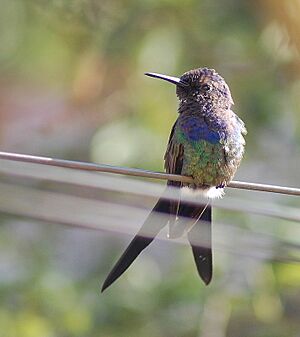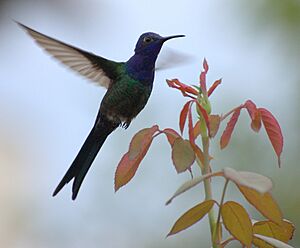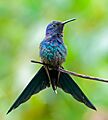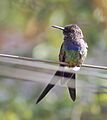Swallow-tailed hummingbird facts for kids
Quick facts for kids Swallow-tailed humming bird |
|
|---|---|
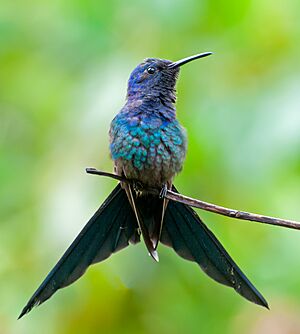 |
|
| Adult in Piraju, São Paulo, Brazil | |
| Conservation status | |
| Scientific classification | |
| Genus: |
Eupetomena
|
| Species: |
macroura
|
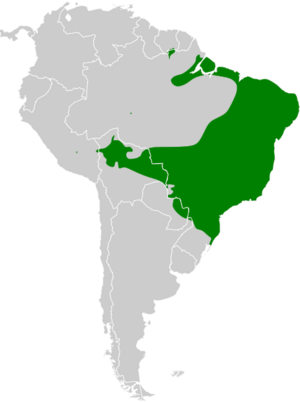 |
|
| Synonyms | |
|
Campylopterus macrourus (Gmelin, 1788) (but see text) |
|
The swallow-tailed hummingbird (Eupetomena macroura) is a type of hummingbird found mostly in east-central South America. It gets its name from its long, deeply forked tail, which looks a bit like a swallow's tail. The scientific name macroura also means "large-tailed" in Ancient Greek.
Contents
About the Swallow-tailed Hummingbird
The swallow-tailed hummingbird was first officially described in 1788 by a German scientist named Johann Friedrich Gmelin. He gave it the scientific name Trochilus macrourus. Today, this hummingbird is placed in the genus Eupetomena. This genus name comes from Ancient Greek words meaning "good" and "always on the wing" or "flying."
There are five different types, or subspecies, of the swallow-tailed hummingbird. They mostly differ in the exact shades of blue and green in their feathers.
- E. m. macroura: Found in the Guianas, Brazil, Paraguay, and northeast Argentina.
- E. m. simoni: Found in northeast Brazil.
- E. m. cyanoviridis: Found in southeast Brazil.
- E. m. hirundo: Found in east Peru.
- E. m. boliviana: Found in northwest Bolivia.
What Does It Look Like?
This is a fairly large hummingbird. It can be 15–17 centimeters (6–6.5 inches) long. Nearly half of this length is its tail! It weighs up to 9 grams (0.3 ounces). In many places where it lives, it is the biggest type of typical hummingbird. Its wings are also quite long for its size, about 8 centimeters (3 inches). Its beak is black and curves slightly downwards.
Its feathers are a bright, iridescent green. This means they shimmer and change color in the light. Its head, upper chest, tail, and belly are blue. It has tiny white tufts of feathers around its ankles. These are common in many hummingbirds.
Male and female swallow-tailed hummingbirds look very similar. However, females are usually a bit smaller and their colors are not as bright. Young birds look like females, but their heads might be duller or have a brownish tint.
The different subspecies have slightly different shades of blue and green. The blue parts can range from greenish-blue to deep royal blue. The green parts can be golden-bronzy green, deep bottle-green, or bluish-green.
This hummingbird makes relatively loud "psek" sounds and softer chirps. When it is excited or worried, it makes a "tik" call. It is quite easy to recognize this bird. Sometimes, people might confuse it with the male violet-capped woodnymph. But that bird only has a blue cap, while the swallow-tailed hummingbird has a blue head and chest.
Where Does It Live?
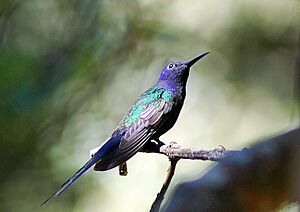
Most swallow-tailed hummingbirds live in the dry forests and savannas of Brazil. These areas are called the Caatinga and Cerrado. They also live in nearby parts of Bolivia and northern Paraguay. Along the coast, they can be found from French Guiana in the north down to Santa Catarina, Brazil, in the south.
They usually avoid thick Amazon rainforest. Instead, they prefer open areas like savannas, gardens, and parks. You can even find them in big cities like Rio de Janeiro and São Paulo. They usually live in lowlands, but sometimes they are found up to 1,500 meters (4,900 feet) high. They don't migrate long distances, but some groups might move a short way north or south during the dry winter months.
This hummingbird is very common in most of its range. However, it is less common in areas that are more humid. In southern Brazil, their numbers seem to be growing, and they have spread to new areas. The IUCN (International Union for Conservation of Nature) considers it a species of Least Concern. This means it is not currently at risk of extinction.
Behavior and Life Cycle
The swallow-tailed hummingbird is quite aggressive. It will defend its food sources from other birds. Because it is large, it usually wins against other hummingbirds. It even attacks much bigger birds by diving at them when they are resting. When it is breeding, it might "dive-bomb" birds that are twice its size or more. These can include birds like Campo flickers or curl-crested jays. It will keep attacking until the bigger birds leave.
If much larger birds like Guira cuckoos or hawks bother it, the hummingbird usually just gives warning calls. However, one female swallow-tailed hummingbird was seen attacking a Swainson's hawk in the air! That hawk weighs more than a hundred times as much as the hummingbird. The hummingbird also gives warning calls to mammals and humans. But in cities, they might get used to people watching them, especially if you stay about 10 meters (33 feet) away.
In one study, a mother hummingbird was seen chasing away ruddy ground doves that tried to nest nearby. These doves are often hunted by smaller predators. By chasing them away, the hummingbird made the area around her nest less attractive to predators. Sometimes, small mammals like common marmosets might try to steal eggs or young from hummingbird nests. The birds will try to defend their babies.
Sadly, young hummingbirds can sometimes get sick from tiny fly larvae called Philornis botfly. These parasites can even kill many young birds.
Food and Feeding Habits
The swallow-tailed hummingbird usually looks for food in the middle parts of trees. But it will go anywhere from near the ground to the very tops of trees if there is good food. It mainly eats nectar from flowers. It especially likes flowers from plants like peas, African violets, mallows, and myrtles. It also eats nectar from plants that grow on other plants, called epiphytic Bromeliaceae. It is not a picky eater and will also get nectar from other types of plants. It also catches insects while flying. In cities in southeastern Brazil, where they are common, they often visit hummingbird feeders.
Reproduction
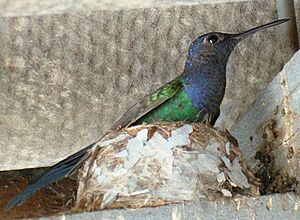
Swallow-tailed hummingbirds can be found doing things related to breeding almost all year round. During courtship, the male hummingbird hovers in front of the female. He also chases her through the air. Sometimes, they fly together in a "zig-zag" pattern. The hovering happens throughout the day, except when it's hottest around noon. The chases happen most often around sunset.
People have seen these birds carrying materials for their nests between July and September, and also in December. The nest is shaped like a cup. It is built with soft plant fibers and covered on the outside with lichen and moss. These materials are held together with spider webs. The nest is usually placed on a flat branch in a small tree, often below 3 meters (10 feet) from the ground. But sometimes, it can be as high as 15 meters (50 feet).
The female lays two white eggs. Like other hummingbirds, only the female takes care of the eggs and the young. The chicks hatch after 15–16 days. When they first hatch, they don't have many feathers, just some gray fuzz on their backs. Their skin is dark. They start growing feathers about 5 days after hatching. The young birds are fed about 1-2 times every hour. The female spends about half her day sitting on the nest and feeding her babies. The other half of the day she spends flying around and feeding herself.
The young birds leave the nest after 22–24 days. But they still come back to the nest to sleep and be kept warm for a few more days. They become fully independent about 2–3 weeks after leaving the nest. A pair of hummingbirds might raise two groups of babies in a row. Sometimes, they even reuse the same nest. These birds usually start breeding when they are 1–2 years old.
Images for kids



